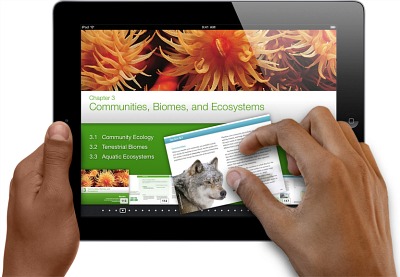Lots of potential—if you’re in a Mac environment, says Buffy Hamilton, school librarian
See also: Audrey Watters puts iBooks Author through its paces (with illustrations) in “Hands on With iBooks Author”
Not satisfied with your current textbook? Well, now you can make a new one.
In a move to turn textbook publishing on its ear, Apple today launched ebook creation app iBooks Author, and iBooks 2, an app supporting iBooks textbooks for the iPad. The fully interactive textbooks, featuring 3-D models, video, and multi-touch functionality will be available in the iBookstore. Apple has partnered with content providers Pearson, McGraw-Hill, Houghton Mifflin Harcourt, and DK Publishing, among others on textbooks for the high school level.
Both authoring and textbooks apps are available as free downloads from the App Store and Mac App Store respectively.
While Apple isn’t getting into the content side of the book biz, it’s encouraging the public at large to do just that—and focusing on textbooks in particular.
“You’ve heard us say that Apple exists at the intersection of liberal arts and technology,” says Philip Schiller, Apple’s senior vice president of worldwide marketing, during the presentation at Manhattan’s Guggenheim Museum Thursday morning. “Nowhere is that more clear than in our investment in education.”
But it’s unclear where schools without iPads—the most likely home for these new apps—fit in this scenario. Many schools are just now adopting ereaders, such as Nooks and Kindles, with others purchasing small numbers of iPads. Yet few schools have completely adopted the iPad device—a fact that Apple must hope to change.
“This is all fine and good if you have a fleet of iPads available,” says Buffy Hamilton, a school librarian at Creekview High School in Canton, GA, also known for her blog “The Unquiet Librarian.” “If you’re in a Mac environment or are one-to-one with iPad there’s definitely a lot of potential there with the interactivity and content creation aspects. But who is going to get excluded? My district is PC-based and there is not enough money to change to Macs.”
Starting with Apple’s new textbook section of its iBookstore, students will be able to sample titles before downloading books with features including 3-D models, interactive question-and-answer sections at the end of chapters, plus the ability to highlight text with just a swipe of a finger.
The textbooks, some of which are already live, start at $14.99 each—far below the cost of current digital textbooks. But the new pricing structure could change, says at least one publisher.
“That’s the current pilot pricing,” says Lisa O’Masta, vice president of STEM marketing at McGraw-Hill Education. “As we understand or learn more we may need to adjust that.”
The iBook Author app—while allowing students to create their own textbooks—will also enable anyone to build any kind of interactive ebook—from a storybook to a cookbook—through the free suite of tools. From a series of templates, users can drag and drop to create pages, even add HTML and JavaScript code to include more customized widgets, and can preview on the iPad before publishing.
Apple’s move into the ebook publishing world had long been expected, particularly as ebook readership is growing. Digital library publisher OverDrive saw checkouts jump to 35 million digital titles in 2011 from 15 million in 2010. Yet publishers themselves are growing increasingly concerned about their titles in digital formats and, in some cases, preventing libraries from having access to their catalogs. Case in point, Penguin, which yesterday suspended the availability of audiobook titles for library purchase, and after announcing in November plans to cut library access to new ebooks.
But Apple is looking beyond ebooks and has also enhanced its distance learning tool, unveiling a new app for its existing iTunes U catalog of free educational content, and expanding the offering to allow full course access for the first time to K–12 districts. Besides the available online courses, the iTunes U app enables students to access teachers’ notes and outlines, contact professors, and even rate their classes.
How Apple’s most recent innovations will play out in K–12 schools remains to be seen as educators, students, and school districts start to examine the options for their classrooms—and often skimpy budgets.
“I think there’s obviously interesting possibilities there but I don’t think this is a turnkey solution that we all wished was available,” says Hamilton. “But maybe this is an evolution and a next step in that journey.”



